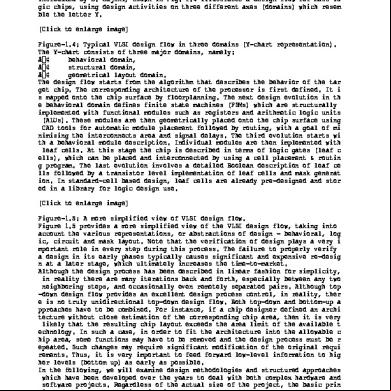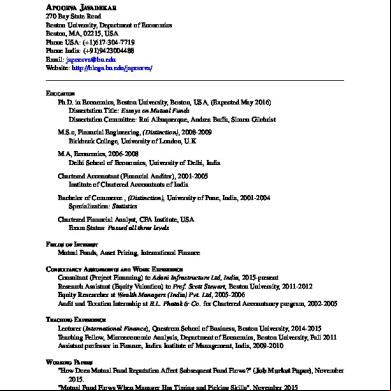Soc Design Flow 4ct40
This document was ed by and they confirmed that they have the permission to share it. If you are author or own the copyright of this book, please report to us by using this report form. Report l4457
Overview 6h3y3j
& View Soc Design Flow as PDF for free.
More details h6z72
- Words: 792
- Pages: 16
SOC Design Flow
General Guidelines for Design Reuse • • • • • •
Synchronous design Memory & Mixed signal design Onchip buses Clock distributions Clear/set/reset/signals Deliverable Models
Synchronous design • Data changes based on clock edges only, hence instructions and data are easily manageable . • Use of s in random logic as well as registration at the inputs and outputs of every core. • Latch-based designs on the other hand are not easy to manage because the data capture is not based on a clock edge; instead, it requires a longer period of an active signal. • Generally asynchronous loops and internal pulse generator circuits should be avoided in the core design
• Multicycle paths and direct combinational paths from block inputs to outputs should be avoided. If there are any asynchronous clear and set signals, then their deactivation should be resynchronized. • The memory boundaries at which read, write, and enable signals are applied should be synchronous and -based
Memory & Mixed signal design • The memory design itself is technology dependent. • In large memories, the parasitics at the boundary cell are substantially different than the parasitics of a cell in the middle of an array. • It is extremely useful to include rows and columns of dummy cells at the periphery of large memories • Made as a part of the built-in self-repair (BISR) mechanism • In todays SOCs more than 60% of the chip is memories; mixed-signal circuits make up hardly 5% of the chip area. • Most commonly used analog/mixed-signal circuits used in SoC are PLLs, digital-to-analog converters (DACs), analog-to-digital converters (ADCs),and temperature sensors.
Clock distributions • Any mismatch in clocking rules can impact the performance of an entire SoC design. • Includes clock domain analysis, style of clock tree, clock buffering, clock skew analysis, and external timing parameters such as setup/hold times, output pin timing waveforms, and so on. • SoCs consist of multiple clock domains; it is always better to use the smallest number of clock domains. • If two asynchronous clock domains interact, the interaction should be limited to a single, small submodule in the design hierarchy & the interface between the clock domains should avoid metastability
• A simple resynchronization method consists of clock buffering and dual stage flip-flops or FIFOs at the clock boundary • cores contain local PLLs, a low-frequency chip-level synchronization clock should be distributed with on-chip buses. • method to minimize clock skew is to edge-synchronize master and derived clocks
Deliverable Models
Soft core Deliverables • Synthesizable Verilog/VHDL; • Example synthesis script; • RTL compiled module; • Structural compiled module; • Design, timing, and synthesis shells; • Functional simulation testbench; • Installation script; • Bus functional models and monitors used in testbenches; • Testbenches with sample verification tests; • Cycle-based simulation or emulation models; • Bus functional models; • Application note that describes signal slew rate at the inputs, clock skew tolerance, output-loading range, and test methodology.
Hardcore Deliverables • Installation scripts; • ISA or behavioral model of the core; • Bus functional and fully functional models for the core; • Cycle-based emulation model (on request); • Floor planning, timing, and synthesis models; • Functional simulation testbench; • Bus functional models and monitors used in testbenches; • Testbenches with verification tests; • Manufacturing tests; • GDSII with technology file (Dracula deck); • Installation script; • Application note that describes timing at I/Os, signal slew rate, clock distribution and skew tolerance, power, timing data sheet, area, floor plan, porosity and footprint, and technology specifications.
Soft/Firm Core Design flow
Hard Core Design flow
Sign-Off Checklist • • • • • • • • • •
Completely synchronous design; No latches in random logic; No multicycle paths; No direct combinational paths from inputs to outputs; Resynchronization at clock boundary; Resynchronization of all asynchronous set/reset/clear signals; Synchronized write/read at memory boundary; Memory design and placement rule checks; Analog/mixed-signal circuits design and placement rule checks; Guard bands for memory and analog/mixed-signal circuits;
• • • • • • • • • • •
Synchronization and protocol verifications for on-chip buses; Load balancing in clock tree; Isolated clock domains; Buffered clocks at the block boundary; Clock skew within specified margin; ed block inputs/outputs; No combinational loops; No internal tri-states; No reconvergent logic; Static timing analysis done; Electromigration rules check;
• No DRC violations; • • LVS and DRC checks for custom circuits; • • RTL and structural simulation match; • • RTL code coverage; • • Gate-level simulation done; • • Fault grading and simulation done; • • Fault coverage;
• SDF (standard delay format) back-annotated timing; • • Functional simulation done; • • DFT rules (such as scan rules) check is done; • • Timing, synthesis, test, design shell files generated.
General Guidelines for Design Reuse • • • • • •
Synchronous design Memory & Mixed signal design Onchip buses Clock distributions Clear/set/reset/signals Deliverable Models
Synchronous design • Data changes based on clock edges only, hence instructions and data are easily manageable . • Use of s in random logic as well as registration at the inputs and outputs of every core. • Latch-based designs on the other hand are not easy to manage because the data capture is not based on a clock edge; instead, it requires a longer period of an active signal. • Generally asynchronous loops and internal pulse generator circuits should be avoided in the core design
• Multicycle paths and direct combinational paths from block inputs to outputs should be avoided. If there are any asynchronous clear and set signals, then their deactivation should be resynchronized. • The memory boundaries at which read, write, and enable signals are applied should be synchronous and -based
Memory & Mixed signal design • The memory design itself is technology dependent. • In large memories, the parasitics at the boundary cell are substantially different than the parasitics of a cell in the middle of an array. • It is extremely useful to include rows and columns of dummy cells at the periphery of large memories • Made as a part of the built-in self-repair (BISR) mechanism • In todays SOCs more than 60% of the chip is memories; mixed-signal circuits make up hardly 5% of the chip area. • Most commonly used analog/mixed-signal circuits used in SoC are PLLs, digital-to-analog converters (DACs), analog-to-digital converters (ADCs),and temperature sensors.
Clock distributions • Any mismatch in clocking rules can impact the performance of an entire SoC design. • Includes clock domain analysis, style of clock tree, clock buffering, clock skew analysis, and external timing parameters such as setup/hold times, output pin timing waveforms, and so on. • SoCs consist of multiple clock domains; it is always better to use the smallest number of clock domains. • If two asynchronous clock domains interact, the interaction should be limited to a single, small submodule in the design hierarchy & the interface between the clock domains should avoid metastability
• A simple resynchronization method consists of clock buffering and dual stage flip-flops or FIFOs at the clock boundary • cores contain local PLLs, a low-frequency chip-level synchronization clock should be distributed with on-chip buses. • method to minimize clock skew is to edge-synchronize master and derived clocks
Deliverable Models
Soft core Deliverables • Synthesizable Verilog/VHDL; • Example synthesis script; • RTL compiled module; • Structural compiled module; • Design, timing, and synthesis shells; • Functional simulation testbench; • Installation script; • Bus functional models and monitors used in testbenches; • Testbenches with sample verification tests; • Cycle-based simulation or emulation models; • Bus functional models; • Application note that describes signal slew rate at the inputs, clock skew tolerance, output-loading range, and test methodology.
Hardcore Deliverables • Installation scripts; • ISA or behavioral model of the core; • Bus functional and fully functional models for the core; • Cycle-based emulation model (on request); • Floor planning, timing, and synthesis models; • Functional simulation testbench; • Bus functional models and monitors used in testbenches; • Testbenches with verification tests; • Manufacturing tests; • GDSII with technology file (Dracula deck); • Installation script; • Application note that describes timing at I/Os, signal slew rate, clock distribution and skew tolerance, power, timing data sheet, area, floor plan, porosity and footprint, and technology specifications.
Soft/Firm Core Design flow
Hard Core Design flow
Sign-Off Checklist • • • • • • • • • •
Completely synchronous design; No latches in random logic; No multicycle paths; No direct combinational paths from inputs to outputs; Resynchronization at clock boundary; Resynchronization of all asynchronous set/reset/clear signals; Synchronized write/read at memory boundary; Memory design and placement rule checks; Analog/mixed-signal circuits design and placement rule checks; Guard bands for memory and analog/mixed-signal circuits;
• • • • • • • • • • •
Synchronization and protocol verifications for on-chip buses; Load balancing in clock tree; Isolated clock domains; Buffered clocks at the block boundary; Clock skew within specified margin; ed block inputs/outputs; No combinational loops; No internal tri-states; No reconvergent logic; Static timing analysis done; Electromigration rules check;
• No DRC violations; • • LVS and DRC checks for custom circuits; • • RTL and structural simulation match; • • RTL code coverage; • • Gate-level simulation done; • • Fault grading and simulation done; • • Fault coverage;
• SDF (standard delay format) back-annotated timing; • • Functional simulation done; • • DFT rules (such as scan rules) check is done; • • Timing, synthesis, test, design shell files generated.










